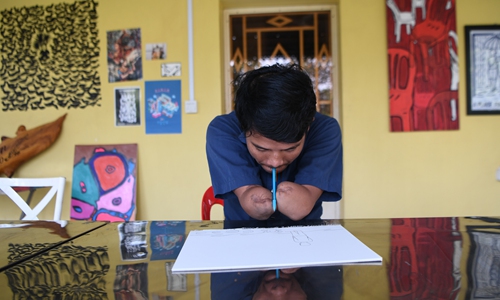Cambodian double amputee artist fights stigma through art
Source:AFP Published: 2020/4/21 16:28:40

Double amputee artist Morn Chear draws at the Open Studio Cambodia on March 6. Photo: AFP
Whispered insults, social isolation, and lost opportunities - Morn Chear is channelling the stigma he has endured since he lost both his hands a decade ago into artwork that highlights the hardships of Cambodia's disabled.
At 20, he was electrocuted in a construction accident and both his hands developed gangrene, pushing doctors to amputate them below the elbow.
"I was depressed, I did not know what I could do to earn money to feed my family," he tells AFP of the shock he felt when he woke up from surgery.
Ten years later, Chear has found his place at an arts collective based in Siem Reap, where he specializes in Linocut block printing - a technique rarely used in Cambodia.
Open Studio Cambodia represents several contemporary artists, selling their pieces out of an airy studio in the heart of a city famed for the Angkor Wat temple complex.
Linocut block printing requires a deft handle to chisel a scene into a block of linoleum, and then applying ink on the print toter where he lost his arms.
"Most of my artwork are all about my real stories," he tells AFP, gesturing at a piece that features himself sitting in a hammock as others walk towards a pagoda.
Chear remembers the incident of his friends snubbing him clear as day - "Don't call him to come with us, he is handicapped, it's embarrassing," he recalls them whispering.
Cambodia has undergone significant changes in the past two decades, with cities like Siem Reap and its capital Phnom Penh developing at break-neck pace to satisfy a growing tourists- and export-reliant economy.
But health and education remain a sticking point, and for people with disabilities, access is even more challenging.
A survey in 2019 by the Cambodian Disabled People's Organization found that 60 percent of the country's disabled live below the poverty line.
Government officials say 310,000 people out of Cambodia's 16 million-strong population have disabilities - though the number is likely higher as many fall between the gaps.
Discrimination is rife, with Cambodians seeing the disabled as street beggars or a burden to their families.
For Chear, social isolation from peers was the most cutting.
He was nicknamed "A-Kambot" by villagers, a derogatory Khmer word for the handicapped, after his return home - which "pierced" him deeply, and made him question whether life was worth living.
Relief came in 2015 when he was recruited into a nonprofit group's training program - teaching him contemporary dance, drawing, computer skills, and even English.
Working with Open Studio Cambodia in 2018 seemed a natural move, as it fueled his drive to use art to persuade the public to see the disabled as capable people.
"Some people who looked down on me in the past have become friendly again," says Chear.
But now, with the coronavirus pandemic, he is reminded of the social isolation he endured right after he lost his arms.
"I hope we will overcome it," he tells AFP from his home in Kampot province, returning after the workshop was temporarily closed.
"If I can't make art, I don't know what I can do."
Newspaper headline: Creating hope
Posted in: ART,CULTURE & LEISURE,ARTS FOCUS